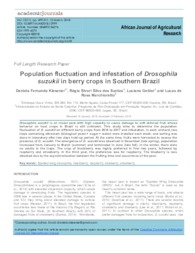Population fluctuation and infestation of Drosophila suzukiiin berry crops in Southern Brazil.
Population fluctuation and infestation of Drosophila suzukiiin berry crops in Southern Brazil.
Autoria: KLESENER, D. F.; SANTOS, R. S. S. dos; GEBLER, L.; MARCHIORETTO, L. de R.
Resumo: Drosophila suzukii is an insect pest with high capacity to cause damage to soft-skinned fruit whose behavior on host crops in Brazil is still unknown. This study aims to determine the population fluctuation of D.suzukii on different berry crops from 2014 to 2017 and infestation. In each orchard, two traps containing attractant (biological yeast + sugar + water) were installed each week; and sorting was done in laboratory after two days hold-up period. At the same time, fruits were harvested to assess the presence of D. suzukii. The emergence of D. suzukii was observed in December (late spring), population increased from January to March (summer) and terminated in June (late fall). In the winter, there were no adults in the traps. The crop of blackberry as highly preferred in first two years, followed by raspberry and strawberry. In the third year, the preference was for raspberry. The blueberry is less attacked due to the asynchronization between the fruiting time and occurrence of the pest. Key words: Spotted wing drosophila, blackberry, raspberry, blueberry, strawberry.
Ano de publicação: 2018
Tipo de publicação: Artigo de periódico
Unidade: Embrapa Uva e Vinho
Palavras-chave: Blackberry, Blueberry, Raspberry, Spotted wing drosophila, Strawberry
Observações
1 - Por padrão são exibidas publicações dos últimos 20 anos. Para encontrar publicações mais antigas, configure o filtro ano de publicação, colocando o ano a partir do qual você deseja encontrar publicações. O filtro está na coluna da esquerda na busca acima.
2 - Para ler algumas publicações da Embrapa (apenas as que estão em formato ePub), é necessário ter, no celular ou computador, um desses softwares gratuitos. Sistemas Android: Google Play Livros; IOS: iBooks; Windows e Linux: software Calibre.
Acesse outras publicações
Acesse a Base de Dados da Pesquisa Agropecuária (BDPA) para consultar o acervo completo das bibliotecas da Embrapa.

